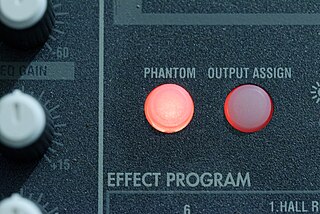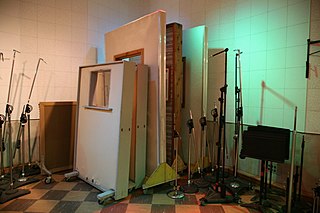
A recording studio is a specialized facility for recording and mixing of instrumental or vocal musical performances, spoken words, and other sounds. They range in size from a small in-home project studio large enough to record a single singer-guitarist, to a large building with space for a full orchestra of 100 or more musicians. Ideally, both the recording and monitoring spaces are specially designed by an acoustician or audio engineer to achieve optimum acoustic properties.
Sennheiser electronic GmbH & Co. KG is a German audio equipment manufacturer headquartered in Wedemark. Sennheiser specializes in equipment for both the consumer and professional audio markets, including microphones, headphones, and loudspeakers.

Phantom power, in the context of professional audio equipment, is DC electric power equally applied to both signal wires in balanced microphone cables, forming a phantom circuit, to operate microphones that contain active electronic circuitry. It is best known as a convenient power source for condenser microphones, though many active direct boxes also use it. The technique is also used in other applications where power supply and signal communication take place over the same wires.

Alesis Digital Audio Tape, commonly referred to as ADAT, is a magnetic tape format used for the recording of eight digital audio tracks onto the same S-VHS tape used by consumer VCRs, and the basis of a series of multitrack recorders by Alesis. Although originally a tape-based format, the term ADAT later also referred to hard disk recorders like the Alesis ADAT HD24. In 2004, recognizing the ADAT for "beginning a revolution of affordable recording tools," it was inducted into the first-ever TEC Awards TECnology Hall of Fame.

Power Station at BerkleeNYC is a recording studio at 441 West 53rd Street in the Hell's Kitchen neighborhood of Midtown Manhattan in New York City originally founded in 1977 as Power Station and known as Avatar Studios from 1996 to 2017. Renowned for its exceptional acoustics, the studio has been the site of hundreds of gold, platinum, and Grammy-winning recordings.
Solid State Logic (SSL) is a British company based in Begbroke, Oxfordshire, England that designs and markets audio mixing consoles, signal processors, and other audio technologies for the post-production, video production, broadcast, sound reinforcement and music recording industries. SSL employs over 160 people worldwide and has regional offices in Los Angeles, Milan, New York City, Paris, and Tokyo, with additional support provided by an international network of distributors. Solid State Logic is part of the Audiotonix Group.

A noise gate or simply gate is an electronic device or software that is used to control the volume of an audio signal. Comparable to a compressor, which attenuates signals above a threshold, such as loud attacks from the start of musical notes, noise gates attenuate signals that register below the threshold. However, noise gates attenuate signals by a fixed amount, known as the range. In its simplest form, a noise gate allows a main signal to pass through only when it is above a set threshold: the gate is "open". If the signal falls below the threshold, no signal is allowed to pass : the gate is "closed". A noise gate is used when the level of the "signal" is above the level of the unwanted "noise". The threshold is set above the level of the "noise", and so when there is no main "signal", the gate is closed.
Shure Incorporated is an audio products corporation headquartered in the USA. It was founded by Sidney N. Shure in Chicago, Illinois, in 1925 as a supplier of radio parts kits. The company became a consumer and professional audio-electronics manufacturer of microphones, wireless microphone systems, phonograph cartridges, discussion systems, mixers, and digital signal processing. The company also manufactures listening products, including headphones, high-end earphones, and personal monitor systems.
The Shure SM57 is a low-impedance cardioid dynamic microphone made by Shure Incorporated and commonly used in live sound reinforcement and studio recording. It is one of the best-selling microphones in the world. It is used extensively in amplified music and has been used for speeches by every U.S. president since its introduction in 1965. In 2004, honoring its four decades of "solid, dependable performance", it was inducted into the first-ever TEC Awards TECnology Hall of Fame.

Georg Neumann GmbH is a manufacturer of professional recording microphones. It was founded in by Georg Neumann in 1928 and is based in Berlin, Germany. Their best-known products are condenser microphones for recording, broadcast, and live music production purposes. For several decades Neumann was also a leading manufacturer of cutting lathes for phonograph disks, and even ventured into the field of mixing desks. Today Neumann also manufactures preamplifiers, studio monitors, headphones, and audio interfaces.
George Y. Massenburg is a Grammy award-winning recording engineer and inventor. Working principally in Baltimore, Los Angeles, Nashville, and Macon, Georgia, Massenburg is widely known for submitting a paper to the Audio Engineering Society in 1972 regarding the parametric equalizer.
Gated reverb or gated ambience is an audio processing technique that combines strong reverb and a noise gate that cuts the tail of the reverb. The effect is typically applied to recordings of drums to make the hits sound powerful and "punchy" while keeping the overall mix clean and transparent sounding.

Automated Processes Inc. is an American company that designs, manufactures, and markets mixing consoles and signal processors, including modular signal processor units in the 500-series format standard that evolved from early API mixing consoles.

The Neumann U 47 is a large-diaphragm condenser microphone. It is one of the most famous studio microphones and was Neumann's first microphone after the Second World War. The original series, manufactured by Georg Neumann GmbH between 1949 and 1965, employed a tube design; early U 47s used the M 7 capsule, then replaced by the K 47 from 1958. Units produced before 1950 were distributed by Telefunken and bear the Telefunken logo.

Spill is the occurrence in sound recording and live sound mixing whereby sound is picked up by a microphone from a source other than that which is intended. Spill is usually seen as a problem, and various steps are taken to avoid it or reduce it. In some styles of music, such as orchestral music, jazz, and blues, it is more likely to be accepted or even seen as desirable.

The Sennheiser MD 421 is a German cardioid dynamic microphone, widely used for speech in broadcasting and for music in live concerts and the recording studio. Introduced in 1960, the internal large-diaphragm transducer element of the MD 421 is still produced unchanged by Sennheiser. The MD 421 is considered a classic, an industry standard. More than 500,000 units have been sold.
Helios was a brand of mixing consoles custom-designed and built for use in recording studios. Produced from 1969 to 1979, Helios consoles were utilized by many key recording studios to produce numerous notable recordings and played a vital part in the history of British rock.
The 500-series format is a standardized format for a modular signal processor system consisting of a combination of 500-series modules installed within a 500-series chassis, with the chassis providing power and audio connections for the individual modules. Originally invented by Automated Processes, Inc. co-founder Saul Walker, today numerous companies manufacture 500-series format products.
The Solid State Logic SL 4000 is a series of large-format analogue mixing consoles designed and manufactured by Solid State Logic (SSL) from 1976 to 2002. 4000 Series consoles were widely adopted by major commercial recording studios in the 1980s.
The RCA Type 44 microphone is a bi-directional ribbon microphone, or pressure-gradient microphone, first introduced by the RCA Corporation in 1931.











